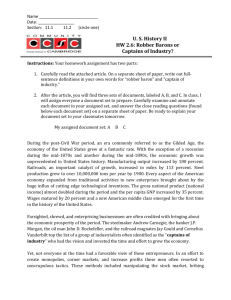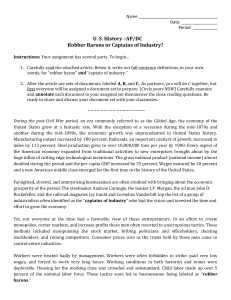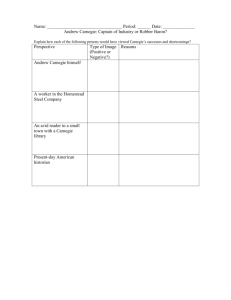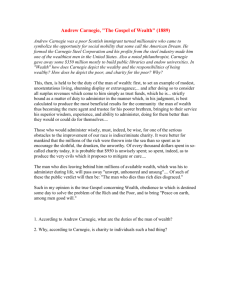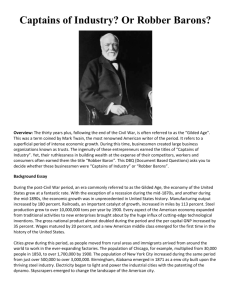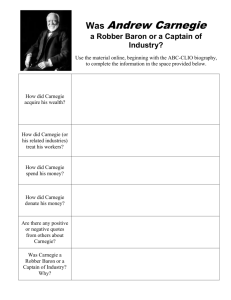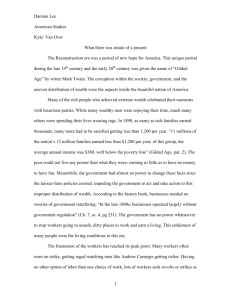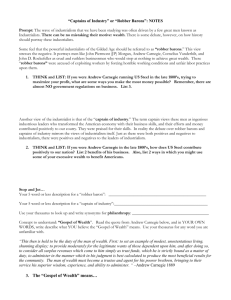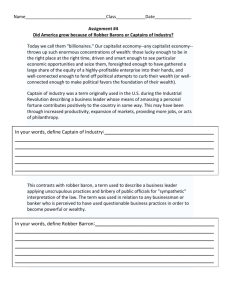DBQ - Captains of Industry
advertisement
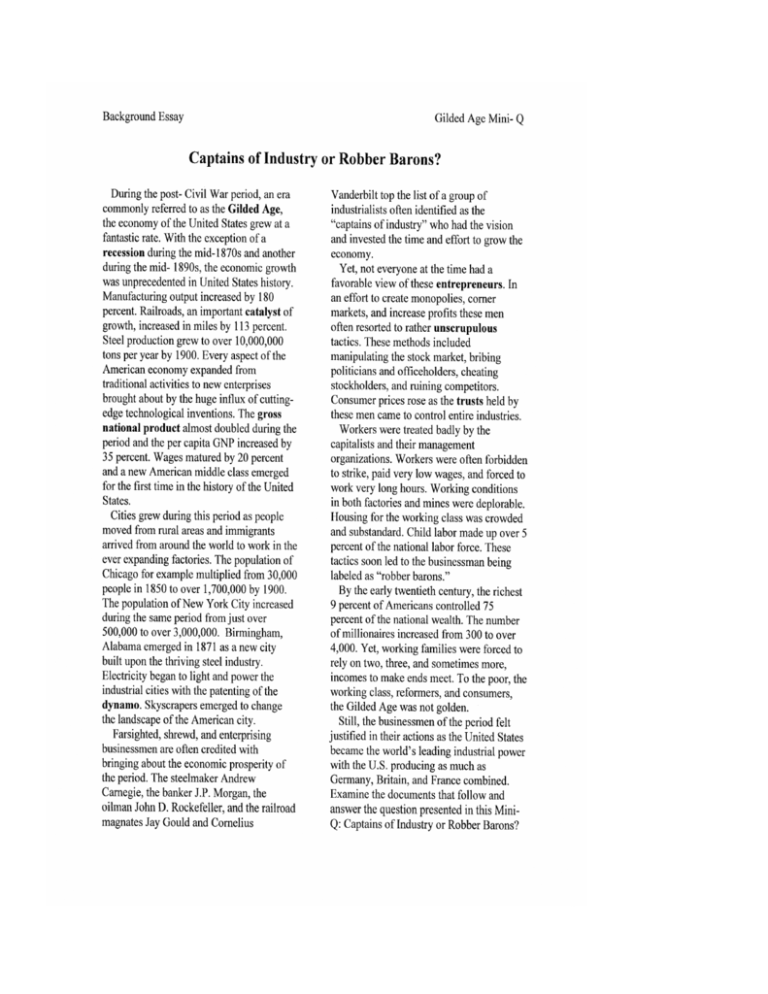
Hook Exercise: Examine the two definitions below. Then, read the list of business activities practiced by businessmen of the Gilded Age. In the blank space following each activity, write C if the activity describes an activity practiced by someone who first the definition of Captain of Industry, or R, if the activity describes an activity practiced by someone who fits the definition of Robber Barron. Captain of Industry – a term originally used to describe a business leader whose means of amassing a personal fortune contributes positively to the country in some way. This may have been through increased productivity, expansion of markets, providing more jobs, or acts of philanthropy. Robber Baron – a disparaging term used to describe a powerful 19th century businessman or banker who used questionable or unethical business practices to become powerful or wealthy. 1. After his retirement, Andrew Carnegie donated most of his money (over $350 million) to establish libraries, schools, and universities, as well as a pension fund for former employees. _________ 2. In 1901, J. P. Morgan’s U.S. Steel was the first billion-­‐dollar company in the world with an authorized capitalization of $1.2 billion. The size and productivity of U.S. Steel allowed the U.S. to compete globally against countries such as Britain and Germany. _________ 3. In response to a strike at Andrew Carnegie’s Homestead, Pennsylvania steel plant in 1892, Carnegie and Henry Clay Frick hired Pinkerton detectives to protect strikebreakers brought in to work in the place of striking workers. Ten men were killed and hundreds injured in an attempt to break the strike. _________ 4. In 1895, at the depths of the Panic of 193, J.P. Morgan loaned the U.S. Treasury $65 million in gold, to safeguard the collapse of the U.S. government. __________ 5. The steamboat and railroad tycoon, Cornelius Vanderbilt continuously cut shipping rates to the point that other steamboat and railroad companies could not compete and were forced out of business. _________ 6. The entrepreneur James J. Hill often donated seed, grain and cattle to farmers who had been affected by drought and depression. ________ 7. John D. Rockefeller often resorted to using spies and extortion to influence railroads to work in his favor by offering him kickbacks and rebates that were denied to his competitors. ________ 8. In 1869, Jay Gould and Jim Fisk cornered the gold market by bribing the U.S. Treasury Secretary into not releasing gold into circulation, which drove up the price of gold which Gould and Fisk were hoarding. _______ 9. By 1890, the richest nine percent of Americans held 75 percent of the nation’s wealth. The average yearly income for a worker was $380. Andrew Carnegie had a yearly income of $25 million by 1900. ________ 10. Between 1860 and 1890, the U.S. Patent Office issued over 400,000 patents. The technological innovation and applied science promoted by entrepreneurs brought about many inventions still in use today. _______ Background Essay Questions 1. Which industry was considered a catalyst of economic growth during the Gilded Age? 2. What was the population of the cities of Chicago and New York City in 1900? 3. What were some of the methods used by businessment to create monopolies and increase profits? 4. How were workers treated during the Gilded Age? 5. Match the businessmen listed below with the industry that they controlled. Andrew Carnegie Jay Gould John D. Rockefeller J.P. Morgan 6. Define or explain the following terms: Gilded Age Catalyst Dynamo Unscrupulous Document A Oil Banking Steel Railroads recession gross national product entrepreneur trust Puck The Protectors of our Industries Document Analysis 1. In the cartoon above, what do the men at the top of the image represent? What are they sitting on? 2. In the same cartoon, what do the men at the bottom of the page represent? What are they trying to do? 3. What are some of the industries depicted in the cartoon? 4. What point is the artist trying to make through this cartoon? Document B Source: Andrew Carnegie, Wealth and Its Uses (1907) “It will be a great mistake for the community to shoot the millionaires, for they are the bees that make the most honey, and contribute most the the hive even after they have gorged themselves full.” “While the law (of competition) may be sometimes hard fo rthe individual, it is best for the race, because it insures the survivial of the fittest in every department. Wea ccept and welcome, therefore, as conditions to which we must accommodate ourselves, great inequality of environment, the concentration of business, industrial and commercial, in the hands of the few, and the law of competition between these, as being not only beneficial, but essential for the future progress of the race.” Source: Andrew Carnegie, The Gospel of Wealth (1889) “Thus the problem of Rich and Poor to be solvd. The laws of accumulation will be left free; the laws of distribution free. Individualism will continue, but the millionaire will be a trustee for the poor; entrusted for a season with a great part of the increased wealth of the community, but administering it for the community far better than it could or would have done itself.” Document Analysis 1. In the first quote from Carnegie in Wealth and Its Uses, what does Carnegie mean by “contributing most to the hive”? 2. In the second quote from Wealth and Its Uses, what does Carnegie mean by “survival of the fittest”? What concept is Carnegie promoting with this quote? 3. What do you think Carnegie means by “the problem of the Rich and the Poor”? 4. In the first quote from Wealth and Its Uses, and in the quote from The Gospel of Wealth, what does Carnegie argue is the role of the millionaire in relation to the community? 5. What is the overall point that Carnegie is trying to make with these quotes? Document C This, then, is helf to be the duty of the man of wealth: First, to set an example of modest, unostentatious living, shunning display or extravagance; … and, after doing so, to consider all surplus revenues which come to him simply as trust funds, which he is called upon to administer… to produce the most beneficial results for the community – the man of wealth thus becoming the mere trustee and agent for his poorer brethren, bringing to their service his superior wisdom, experience and ability to administer, doing for them better than they would or could do for themselves. Source: Andrew Carnegie, The Gospel of Wealth (1889) Document Analysis 1. In this quote from The Gospel of Wealth, what expample should the “man of wealth” set? 2. According to this excerpt, how should the “man of wealth” administer the trust fund of his surplus revenues? 3. According to Carnegie, what does the “man of wealth” have, that his ‘poorer brethren” don’t (besides money)? 4. Does this quote indicate that Carnegie is a Captain of Industry, or a Robber Baron? Why? Document D The Grange Awakening the Sleepers (1873) 1. What are the people doing below the tracks? Think about the title. 2. How are railroad depicted in the cartoon? 3. What is the message of the artist of the cartoon? 4. Does this cartoon indicate that Vanderbilt is a Captain of Industry or a Robber Baron? Document E Source: Horace Taylor, The Verdict, September 25, 1899 Document Analysis 1. According to the cartoon, who controls the national government? 2. Who represents the trusts in this cartoon? 3. What industry did this representative dominate? 4. What are some of the symbols of industry represented in this cartoon? 5. The title of this cartoon is “The Trust Giants Point of View”. Describe their point of view. 6. Does this cartoon identify American entrepreneurs as Captains of Industry or Robber Barons? Document F Source: http://www.dcte.udel.edu/hip/resources/lessons/lesson2b/2b_2.pdf Historian B 1953 “Much of the blame heaped on the captains of industry in the late 19th century is unwarranted. Although people like Rockefeller used methods that were ethically questionable, the kind of monopolistic control that the exercised was a natural response to the cutthroat competition of the period and reflected the trend toward business consolidation in all industrial nations. The captains of industry like Rockefeller who were innovators, thinkers, planners, and bold entrepreneurs who imposed upon American industry a more rational and efficient pattern. They also created a model of philathrophy for all to follow. Had it not been for these captains of industry, the free world might have lost the first world war, and most certainly have lost the second.” Document Analysis 1. What view does Historian B have of Gilded Age entrepreneurs? How does he/she describe them? 2. Does the historian admit that the methods of the businessmen of the period are unethical? 3. What does Historian B consider to be the entrepreneur’s major contributions to the free world? 4. Is the quote from Historian B a primary or secondary source? Explain. 5. What is the overall message presented in this quote?
